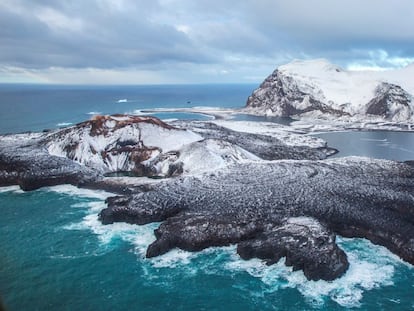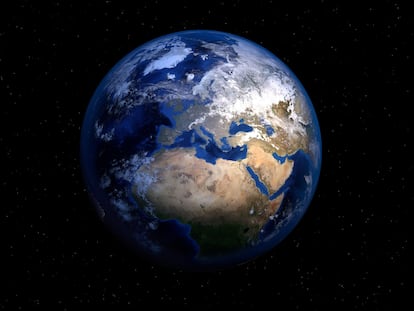The center of the Earth is an iron ball with a radius of 650 kilometers
An analysis of 200 earthquakes confirms the existence of a fifth layer of the planet, the deepest and most unknown one

For decades, textbooks have taught us that the Earth is like a Russian doll containing four main layers, one inside the other: crust, mantle, outer core, and inner core. Now, an analysis of more than 200 earthquakes in the last decade confirms that the inner core contains a fifth, even more internal layer: a sphere of almost pure iron with a radius of 650 kilometers, almost 404 miles.
The inner core of our planet would be unrecognizable to any inhabitant of Earth. The pressure is three million times higher than on the surface and the temperature is around 5,500 degrees Celsius (9,932 degrees Fahrenheit). “If we could dismantle the planet by removing the mantle and the liquid outer core, we would see that the inner core shines like a star,” explained Hrvoje Tkalčić, a geophysicist at the Australian National University and author of the study on the innermost layer of Earth, published on Tuesday in Nature Communications. Understanding the interior of the core is essential to knowing how our planet formed and when it will cease to be a habitable place once the outer core completely solidifies and the magnetic field that protects it from space radiation disappears. That won’t happen for billions of years, but it’s also interesting to understand planets very similar to Earth that have lost their magnetic shield, like Mars.
In 1936, Danish seismology pioneer Inge Lehmann discovered the Earth’s inner core by studying the propagation velocity of earthquakes that crossed the planet from side to side, passing through the core once. Almost 90 years later, the same principle, with much more advanced technology, has made it possible to identify 16 earthquakes among the 200 analyzed that passed through the inner core, not once, but twice, three, four and even five times. This is a type of signal that was in the archives, but that no one had analyzed before. These seismic waves make it possible to study the composition of the inner core with an “unprecedented” level of detail, according to the researchers.
All these earthquake rebounds were recorded at hundreds of seismic stations across all continents. The data show that the waves do not propagate uniformly. Those passing through the innermost part of the core travel a few seconds faster if they run parallel to the Earth’s axis of rotation than if they run in a 50-degree plane, for example. However, in the outermost part of the core the propagation is faster also when parallel to the rotation axis, but the slower direction is just in the plane of the equator, at 90 degrees.
This new X-ray of the Earth shows that the inner core is not a uniform sphere of 1,221 kilometers (759 miles) in radius, but that inside it is another, even more internal and compact sphere of 650 kilometers (404 miles) in radius, according to Tkalčić's work. The study confirms previous estimates, made since the early 2000s. The observations are important for understanding how the innermost core formed and how it has progressed in each epoch of the planet.
At present the inner core is growing by one millimeter per year, explained Tkalčić, adding that if this growing speed has always been constant, that would mean that it is one billion years old. “But the speed has probably not been the same in different epochs of the Earth, so we currently estimate that it is between 200 million years to 1.5 billion years old. It’s one of the biggest uncertainties in modern science. Perhaps this new study of the boundary between the two layers of the inner core can improve models on its evolution,” he said.
The study may clear up another difficult puzzle to solve. The iron in the planet’s core bears little resemblance to that on the surface. Temperatures and pressure are so high that this element forms polyhedral “crystals.” There are two schools of thought, one that holds that the crystals in the core are cube-shaped and another that argues that in the innermost part physics only makes the hexagon possible. The sense of arrangement of these crystals and the atoms that form them would determine the fast and slow directions. “This work seems to lean towards the cubic configuration in the innermost part of the nucleus and the hexagonal in the outermost zones,” explained Maurizio Mattesini, professor of Earth Physics and a researcher at the Institute of Geosciences of Spain’s National Research Council (CSIC-UCM), which specializes in the internal structure of the Earth. “There is still a lack of data to reach a conclusion, but thanks to this type of studies, laboratory simulations and theoretical calculations of quantum mechanics that we do in my group, for example,” the list of possibilities is shrinking, he pointed out. “I think we are close to knowing the truth,” he added.
The researchers filtered the waves of those 16 earthquakes that went through the heart of the planet to keep only the most interesting part. They then compared what they observed with different models of the inner core and the most likely conclusion was the one they present in their study. “When I saw these seismic signals I was stunned,” admitted Puy Ayarza, head of the Department of Geology at the University of Salamanca. “These are completely new seismic phases that allow us to study the inner core very well. It is a very solid work, because there are very few confounding factors,” she emphasized.
This study comes a few weeks after another team led by Xiadong Song showed that the Earth’s outer core – the liquid part that surrounds the inner core and is key to generating the magnetic field – has slowed down. “This work adds interesting data,” said Song, who works at Peking University’s Institute of Theoretical and Applied Geophysics. “The model they present is similar to the one our group proposed a few years ago. But further study is needed to understand the true nature of the deepest part of the planet,” he added.
Sign up for our weekly newsletter to get more English-language news coverage from EL PAÍS USA Edition
Tu suscripción se está usando en otro dispositivo
¿Quieres añadir otro usuario a tu suscripción?
Si continúas leyendo en este dispositivo, no se podrá leer en el otro.
FlechaTu suscripción se está usando en otro dispositivo y solo puedes acceder a EL PAÍS desde un dispositivo a la vez.
Si quieres compartir tu cuenta, cambia tu suscripción a la modalidad Premium, así podrás añadir otro usuario. Cada uno accederá con su propia cuenta de email, lo que os permitirá personalizar vuestra experiencia en EL PAÍS.
¿Tienes una suscripción de empresa? Accede aquí para contratar más cuentas.
En el caso de no saber quién está usando tu cuenta, te recomendamos cambiar tu contraseña aquí.
Si decides continuar compartiendo tu cuenta, este mensaje se mostrará en tu dispositivo y en el de la otra persona que está usando tu cuenta de forma indefinida, afectando a tu experiencia de lectura. Puedes consultar aquí los términos y condiciones de la suscripción digital.
More information
Últimas noticias
Trump claims peace in Ukraine is near, but Moscow suggests otherwise
A survivor’s account of the Interoceanic Train accident: ‘We were scared because of the speed on the curve’
The Interoceanic Train, the Mexican alternative to the Panama Canal
What is known about the Interoceanic Train derailment in Oaxaca
Most viewed
- Oona Chaplin: ‘I told James Cameron that I was living in a treehouse and starting a permaculture project with a friend’
- Reinhard Genzel, Nobel laureate in physics: ‘One-minute videos will never give you the truth’
- Why the price of coffee has skyrocketed: from Brazilian plantations to specialty coffee houses
- Pablo Escobar’s hippos: A serious environmental problem, 40 years on
- Chevy Chase, the beloved comedian who was a monster off camera: ‘Not everyone hated him, just the people who’ve worked with him’











































